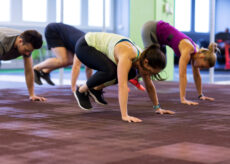How Often Should I Train Abs? (we ask our coaches)

There are several schools of thought when it comes to ab training. Many trainers will have their own predetermined schedules they feel are best for maximal abdominal development. Other gym-goers may see it differently and train abs whenever they can fit them in. How often ab training fits into your workout schedule is up to you and can depend on several factors. That said, the long and short of it is that you can:
- Work abs every day
- Work them like just any other body part
- Work them 2 – 3 times per week
- Work them every other day
- Use high repetitions
- Use heavy weights
- Never work abs and let all your other heavy lifting challenge them
The bottom line is that none of these methods are “wrong,” and as long as you are working the abs, it will probably boil down to personal preference.
Are Ab Muscles Different Than Others?
Abs are pretty much the same as most of the other muscles in the body. So, while muscles may differ in terms of fiber type and distribution, functions, and structure, the basic premises of working your muscles will be similar.
If you want to tone the muscle, you should do a lot of lightweight repetitions, and you can work the area more often. On the other hand, if you’re going for muscle, you’ll want to add some weight to your ab training.
How is Muscle Built?
The strange (or some may say “cool”) thing about building muscle tissue is that you first have to tear it down in order to build it up. You may have heard folks say that muscle is created as you recover rather than in the gym. That’s because it’s the repairing of the torn-down muscle tissue that adds new growth to your physique. Muscles need time to recuperate to recover from strenuous exercise and rebuild themselves, and that includes the abdominal muscles.
What does this mean for you? If you want to build abs, you’ll have to tear them down through heavier resistance training. If you want to tone, then stick with body weight and calisthenic-type exercises.
The Role of Diet in Your Ab Training Program
While it may not technically be part of ab training, it’s worth mentioning diet. You can do ab training all day long every single day but, if you don’t get your diet in check and lower your body fat levels, you’ll never see the fruits of your labor.
Indeed, seeing your abs is largely a function of body fat levels, and you’re going to have to peel away quite a bit to reveal those toned blocks of muscle. So, work your abs according to whichever schedule you choose, but keep that diet in check, so you can appreciate all your hard work!
RELATED: Collagen Doesn’t Work (Unless…)
What Types of Abdominal Exercises Can You Do?
1. Bodyweight/Gravity-Based Exercises

These exercises will pit you against the force of gravity and/or your own body weight. This type of exercise is effective at strengthening and toning the abs.
Because this type of exercise is gentler on the body than heavy weight training, by nature, your muscles will also have the ability to recover rather quickly. You technically could do this type of exercise every day if you wanted to.
Try some of these:
- Planks
- Crunches
- Reverse crunches
- Hanging leg lifts
- V-ups
- Side planks
2. Heavier Weight Ab Training

If you’re going to treat your abs like another body part in your bro-split gym routine, know that you’ll have to rest them up as well, just like you would chest/tris, legs/calves/delts, back/bis.
Decide which body part or parts you want to work abs with. Then, treat them like you would any other body part during the workout with sets, reps, and rest ranges. Use weight and progress to heavier weight over time.
Try some of these:
- Abdominal machines with options to add weight
- Crunches holding a weighted ball, a dumbbell, or a weight plate
- Leg lifts with a small dumbbell between your feet
- Weighted cable crunches
- Woodchopper exercise on a cable machine
3. Skip Ab-Centric Workouts and Do These Exercises

Yes, it is possible to work your abs and never directly use targeted abdominal exercises. Why? It’s because your abdominal muscles help stabilize your body through most movements.
Try some of these:
- Compound movements—what are compound movements? They consist of exercises that combine the use of large muscles and use multiple muscle groups to complete the exercise. Some great examples of compound exercises are squats, deadlifts, overhead presses, bent-over rows, pull-downs, pull-ups, leg presses, hack squats, lunges, and seated rows (any row without back support).
- Do single side exercises—with weight to force your body into using the abs even more to stabilize you throughout the movement. Some great examples of single side movements are single-leg squats or single dumbbell presses (seated, incline, and decline).
If you’re not sure where to start, feel free to try out any ab training combination that works for you or try each variation to see what you like best. And remember, just lifting heavy weights will work your abs as well, so always make sure you incorporate resistance training into your workout program for best results.



 US Doctor: "Eating This Every Day Can Snap You Into Ketosis"
US Doctor: "Eating This Every Day Can Snap You Into Ketosis" 3 Key Nutrients to Help Lubricate Your "Tin Man" Joints
3 Key Nutrients to Help Lubricate Your "Tin Man" Joints AVOID Plant-Based Protein Powders (unless...)
AVOID Plant-Based Protein Powders (unless...)

